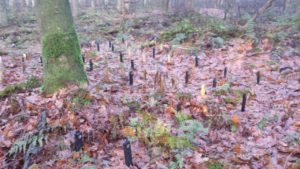The first encounter with the biocoating began in Hamburg, 1996. German researcher Dr. Michael Sailor exhibited a sample piece of what would later be the roots for Xyhlo to grow from during an EU project. The purpose of the exhibition was to explore routes to an environmentally-friendly method of extending the longevity of wood by impregnation with natural oils
The core idea of the research was simple; oil emits water. The absence of water leads to difficulty for fungus to penetrate or corrode the wood. The conducted research which followed existed of a variety of wood samples coated with oils and stuck outdoors in the earth. However, after a couple of months part of these samples had turned into a homogeneous black colour because of fungus.
Further investigation pointed out that the black fungus pestering the wooden samples was a common household endophyte named ‘Aureobasidium pullulans‘, a fungus which did not cause any symptoms or diseases but instead offered protection to the wood underneath. Microscopic research concluded that the black biocoating satisfied criteria for the much sought environmentally-friendly wood protection:
- Containment of an UV-stable, protective layer which does not impair the subject in any way or form.
- Adhesion through fungal growth in the cells of the wood.
- Adhesion through the creation of adhesive polymers.
- The implementation of an oil type with water repellent qualities to ensure dryness of the wood.
- Less moisture leading to less tearing and improved overall protection.
- Protection against harmful micro-organisms and insects.
- Interaction between liquid oil, wood and fungus leading to self-repairing qualities.
The research experienced a surprise turn; instead of the prevention of fungal growth, the prosperous Aureobasidium pullulans fungus could now be deployed for its protective qualities. The much sought environmentally-friendly protection had been discovered and as a surprise-bonus; would be a 100% natural by design.
TNO Delft
The further exploration stages of the newly discovered protective biocoating literally crossed boundaries as the research relocated from Germany to TNO, The Netherlands. Michael Sailor started his employement at TNO in 2002 for the sole reason of further development, taking the biocoating to the next level through years of hardship and intensive collaborating with different wood-enterprises. Together they overcame varying practical hurdles such as the poor, adhesive qualities of the fungus, bacterial infections, ado with snails and discolouring of the fungus.
However, the biggest challenge turned out to be the transformation from a, under laboratory conditions created, biological principle to an useable and purposeful biofinish. To increase the amount of fungus the comprehensive collaboration with IMenz, a private bioengineering association specialised in the development of biorefinery, turned out especially memorable.
Through the years, we had the honour of collaborating with many more (expert)partners on the development of Xyhlo biofinish.
In early 2016 Xyhlo biofinish thrived and was now ready for real-market consumption. The first project to utilize Xyhlo biofinish was the care center Da Costa in Putten, The Netherlands. In collaboration with Regge Hout from Goor, wood destined for facade cladding would be prepared with environmentally-friendly biofinish for the first time. The project has been delivered in May, 2016.
Considering Xyhlo biofinish?
Inspired to get started with our eco-friendly and CO2-neutral Xyhlo biofinish? Request a free sample of softwood coated with Xyhlo biofinish for a hands on experience to experience the benefits for yourself, no strings attached!




